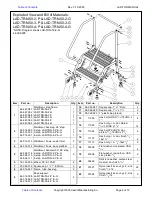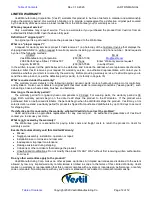
Rev. 3.19.2020
LAD-TRN MANUAL
Copyright 2020 Vestil Manufacturing Co.
Page 10 of 12
RECORD OF SATISFACTORY CONDITION (THE “RECORD”)
After assembling the ladder and before putting it into service, visually inspect the ladder. Record the condition and
appearance of each of the frame members (step weldment, back leg weldment, base support frame members), the
handrails, outriggers, wheels and/or casters, (leg) caps, back platform frame and chain, and all fasteners (bolts, nuts,
etc.). Thoroughly photograph the ladder from multiple angles. Include close range photographs of the rubber leg caps,
casters and wheels, all labeling, and all handrail connections. Add the photographs to the record. Collate all
photographs and writings into a single file. This file is a record of the ladder in satisfactory condition. Compare the
results of all inspections to this Record to determine whether the ladder is in satisfactory condition. Do not use the
ladder unless it is in satisfactory condition. Purely cosmetic changes, like damaged paint or powdercoat, are not
changes from satisfactory condition. However, touchup paint should be applied as soon as damage occurs.
NATIONAL STANDARDS
This product is a “mobile ladder stand” (MLS).
(the “Standard”) applies to MLS’s. You
should
acquire a copy of the latest version of the standard. Follow all use and maintenance/care instructions provided
in the Standard as well as all other provisions for MLS owners and users. If any content in this manual conflicts with
any mandatory provision(s) in the Standard, apply the provision(s) from the Standard. Vestil encourages you to
immediately contact
TECHNICAL SERVICE
if you discover any inconsistencies.
USING THE LADDER
Review the
SAFETY INSTRUCTIONS
on p. 3 before using the
ladder.
Inspect the ladder before each use for damage, such as unusual
wear, deterioration, or corrosion. Tighten loose nuts. If a lock nut has
been partially or completely unfastened, it must be replaced with a
new lock nut.
Make sure there are no children in the area where the ladder is
used
or stored
.
Climbing the ladder:
ONLY use the ladder on even, level, improved surfaces (concrete or asphalt).
Never use the ladder on angled
surfaces. The ladder must not wobble or lean while in use. Only climb the ladder when the steps and handrails are
clean and dry.
Stand on the bottom step and confirm that the caps solidly contact the ground. The rubber caps on the bottoms of
the legs should prevent movement. Face the ladder and grasp the handrails while ascending and descending the
steps. Do not lean against the handrails or the platform chain.
Before moving the ladder, completely empty the tool tray. Move the ladder by standing in front of it, grasping the
handrails, and rotating the ladder towards you until both wheels contact the ground and are able to roll. Push the
ladder to the desired location. Ladders with more steps are heavier and therefore require more effort to manipulate.
Step 6: Install the platform bar using the hardware shown in the diagram.
Mounting
bracket
Platform bar
44-514-314
Side rail
Lock
washer
33622
Flat
washer
33008
Bolt
11107




























